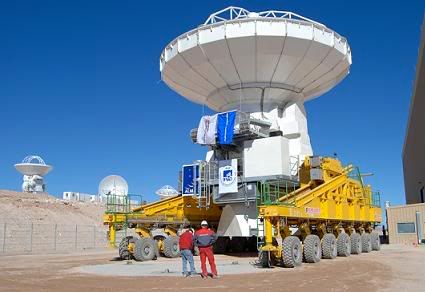Post by glactus on Sept 30, 2009 4:05:37 GMT

An ALMA antenna en route from the Operations Support Facility to the plateau of Chajnantor.
The ALMA (Atacama Large Millimeter/submillimeter Array) astronomical observatory has taken another step forward - and upwards. One of its state-of-the-art antennas was carried for the first time to the 5,000-meter plateau of Chajnantor, in the Chilean Andes, on the back of a custom-built giant transporter.

The Alma array
The antenna, which weighs about 100 tons and has a diameter of 12 meters, was transported up to the high-altitude Array Operations Site, where the extremely dry and rarefied air is ideal for ALMA's observations of the Universe.
This is a part of the UK's major technical contribution to ALMA, which also includes supplying receiver cryogenics and components, and software. The receivers detect the extremely faint signals from space, making them vital components within the overall set-up.
The ALMA UK Project Manager, Professor Brian Ellison, said, "Transportation of the first of the ALMA antennas to the high-altitude observing site represents another significant step forward in the construction of this world-class telescope."
The ALMA antennas are the most advanced submillimeter-wavelength antennas ever made. They are designed to operate fully exposed in the harsh conditions of the Array Operations Site.
This means surviving strong winds and temperatures between +20 and -20 degrees Celsius whilst being able to point precisely enough that they could pick out a golf ball at a distance of 15 km, and to keep their smooth reflecting surfaces accurate to better than 25 micrometers (less than the typical thickness of a human hair).
Ultimately, ALMA will have at least 66 antennas distributed over about 200 pads, spread over distances of up to 18.5 km and operating as a single, giant telescope.
Even when ALMA is fully operational, the transporters will be used to move the antennas between pads to reconfigure the telescope for different kinds of observations.
ALMA will help astronomers answer important questions about our cosmic origins. The telescope will observe the Universe using light with millimeter and submillimeter wavelengths, between infrared light and radio waves in the electromagnetic spectrum.
The Universe is relatively unexplored at submillimeter wavelengths, as the telescopes need extremely dry atmospheric conditions, such as those at Chajnantor, and advanced detector technology.
Credits:Alma array image Astronomy.com
www.astronomynow.com/nam09/SKA.jpg
Transporter image: CV,NRAO.edu
www.cv.nrao.edu/~awootten/mmaimcal/Xporter9Vx2.jpg
Text: Space daily,com:
www.spacedaily.com/reports/ALMA_Telescope_Reaches_New_Heights_999.html


